At a glance
Expert’s Rating
Pros
- More and snazzier-looking designs
- Better battery life
- Improved audio quality
- Connects to multiple Bluetooth devices at once
Cons
- Improved bass still isn’t that great
- Auto-volume feature on previous Frames is missing
- Bulky charging cradle
Our Verdict
Amazon’s third-generation Echo Frames arrive with several welcome improvements, including new styles, thinner temples, better audio, and improved battery life. But you’ll still want your AirPods when it comes to music.
Price When Reviewed
$269.99 (Modern Rectangle frames with prescription-ready lenses)
Best Prices Today: Amazon Echo Frames (3rd gen)
$269.99
Amazon takes several steps forward but a couple steps back with the latest version of its Echo Frames smart glasses. The new Frames deliver boosts to battery life and audio quality, while also offering a variety of new and appealing styles. You also get some key convenience features, including the ability to find your lost Frames on a map as well as connect them to multiple Bluetooth devices. Taken together, these are all welcome, if shy of game-changing, improvements.
But we do have a few bones to pick with the third-generation Echo Frames, such as a missing auto-volume feature that was present on the second-gen Frames. The newer Frames also come with a new charging cradle that–while more solid and reliable than the flimsy cable that charged earlier Frames–is more of a pain to tote around. And while sound quality on the new Frames has clearly been improved, it still pales compared to a decent set of earbuds when it comes to enjoying music.
Still, the third-gen Echo Frames rank up there with the best smart glasses available (not that the field is all that crowded), and for those who want Alexa hovering around their temples all day, the Frames are an easy recommendation. Should you upgrade from the second-generation Frames? If you’re looking for a different style, sure, but the new Frames don’t represent a quantum leap over the previous version.
The third-generation Echo Frames are the best Frames yet, even if they’re not a must-have upgrade for second-gen Frames users.
For those entirely new to Amazon’s Echo Frames line, I suggest checking out my review of the second-generation Frames, which delves more into the basics of these smart glasses. The following review focuses more on the difference between the second- and third-generation Frames.
Design
One of the biggest changes with the third-generation Echo Frames is the number of styles available. For the previous Frames, there was a single, somewhat boxy and retro-looking design (which I somewhat liked). Now, there are five distinct frame styles–including square, round, cat eye, rectangle, and modern rectangle—in colors ranging from black and blue to brown and gray. Meanwhile, Italian eyewear brand Carerra will be offering its own (pricier) Cruiser and Sprinter frames. You’ll have to decide for yourself if any of the new Frames styles are to your liking, but in my book, having more choices is always an improvement. (Amazon sent the modern rectangle frames in charcoal gray for review.)
Another noticeable improvement for the third-gen Frames comes in the form of oh-so-slightly thinner temples—about 15 percent thinner, according to Amazon. This design change is most noticeable when viewing the Frames from above, and while the temples still look thicker than those of standard “dumb” frames, they’re not as egregiously chunky as the temples on the previous-generation Frames. Either way, both the second- and third-gen Frames do a good job of hiding the girth, and it’s doubtful that passersby would notice anything unusual.
Depending on the style, the third-gen Echo Frames weigh anywhere between 37 and 46 grams (or 1.3 to 1.6 ounces). According to my scale, the modern rectangular Echo Frames that I tested are 38 grams. In any event, the Frames felt pleasingly light in my hands and comfortable to wear, although they did tend to slip down my nose every so often.
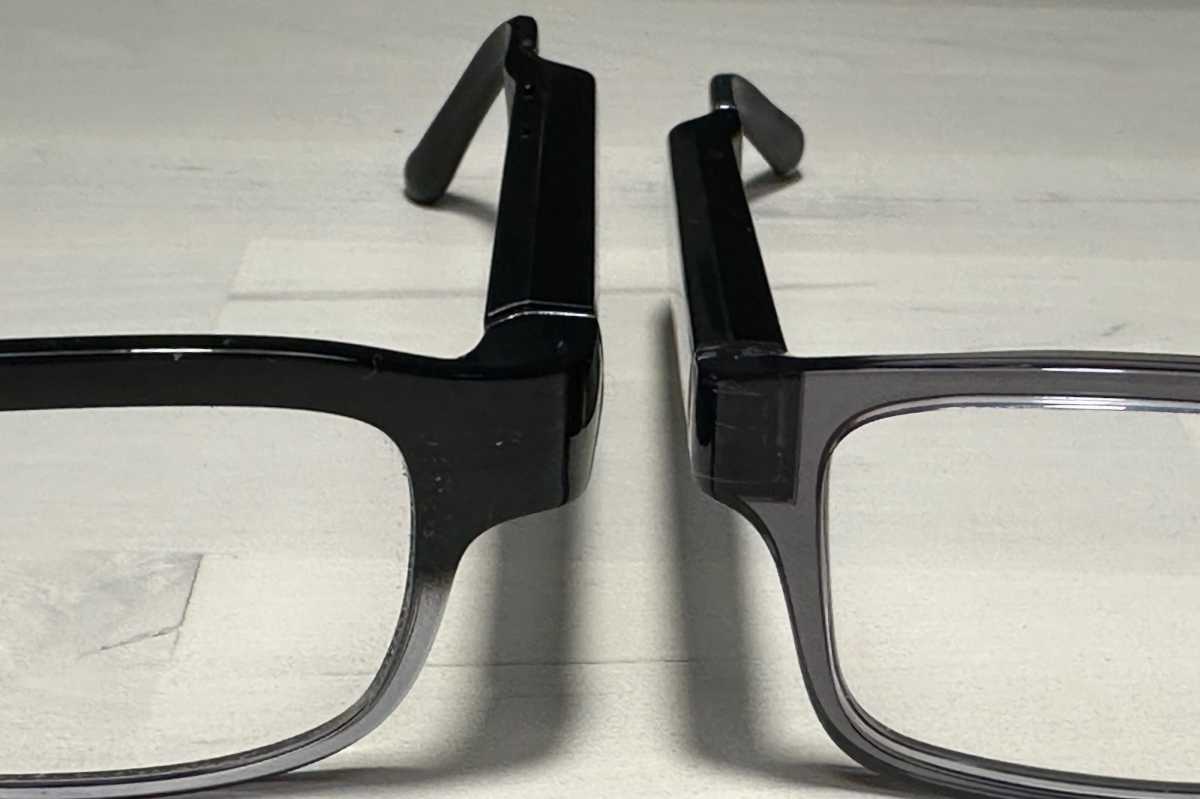
The temples on the third-gen Echo Frames (right) are 15-percent thinner on the previous version (left).
Ben Patterson/Foundry
As with its predecessor, the third-generation Frames feel light but sturdy, with the new Frames made from an Italian acetate plus “premium metal tone finishes,” along with “soft-touch” silicone temples bolstered by a titanium core. I thought the second-generation Frames looked pretty sleek, but the new Frames are a tad more stylish, particularly thanks to the metal accents. With an IPX4 rating, the Frames are resistant to water splashes in any direction, meaning they’re safe to wear during a rain shower.
You have your choice of three lenses: blue-light filtering, polarized sunglass lenses, and clear prescription-ready. Same as with previous Frames, you can have the third-generation Frames fitted online, or take them (along with a set of printable instructions) to a local eyewear professional.
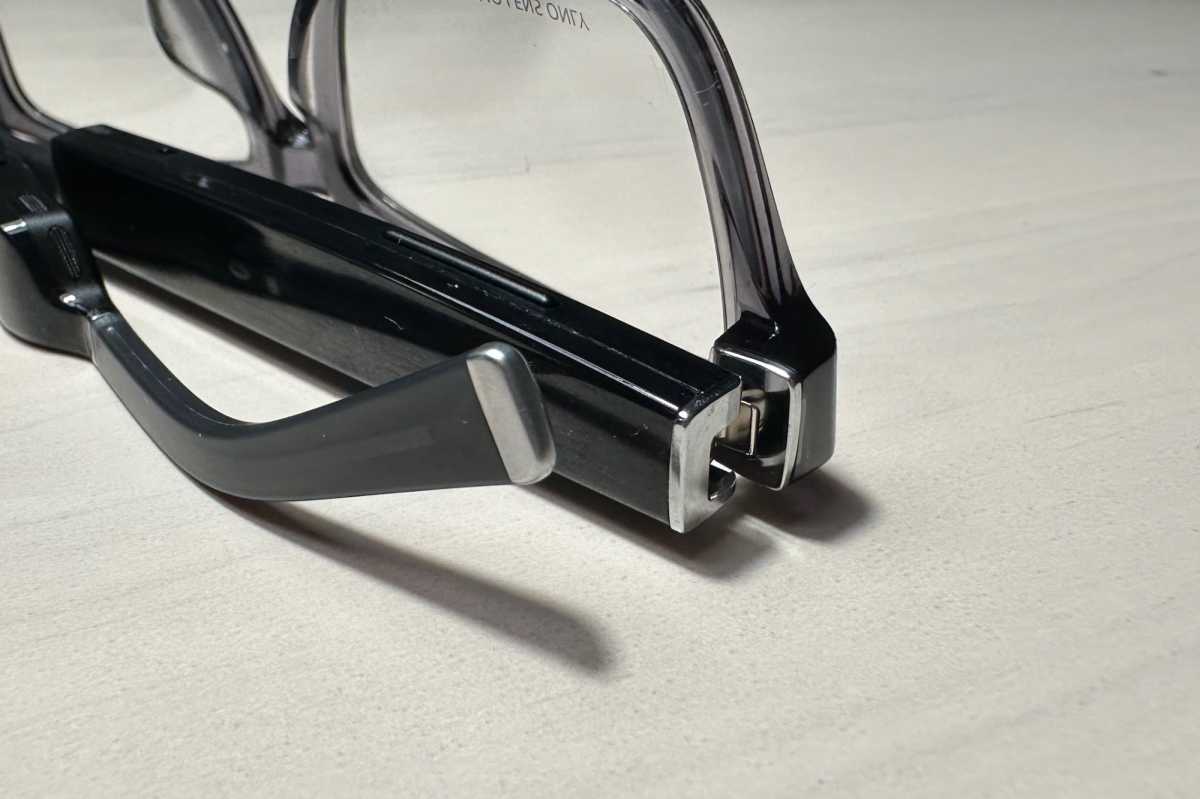
The new metal accents give the third-gen Echo Frames a more premium look.
Ben Patterson/Foundry
Buttons and LEDs
The third-generation Frames have moved things around a bit when it comes to the various buttons and controls. For starters, the long, thin volume rocker that resided on the bottom edge of the right temple for the second-gen Frames has been shifted to the left temple for the new version, making room for a second “action” button on the right temple.
Gone from the third-gen Frames is the touchpad that sat on the outside of the second-gen’s right temple, with most of the touchpad’s duties—such as answering calls—now relegated to one of the two action buttons.
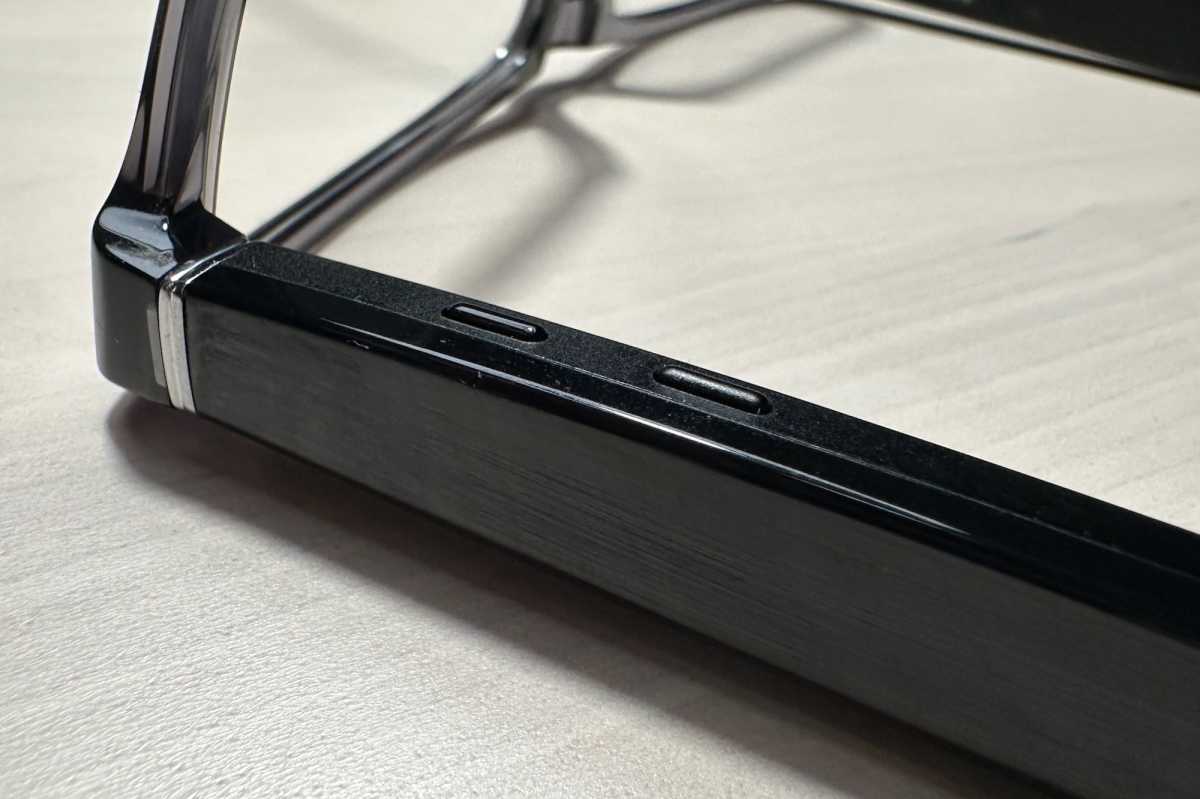
There are now two “action” buttons on the underside of the right temple.
Ben Patterson/Foundry
You can customize the functions of the two little action buttons; for example, a long-press of the first action button can summon Alexa, while a long-press of the second button can wake your phone’s voice assistant. Similarly, a single-press of the first action button can prompt Alexa to give you the details of a notification chime (more on those in a moment), while a double-press of the back button can automatically launch a favorite playlist on Amazon Music, Apple Music, Spotify, or Pandora. One former touchpad function that’s now completely gone is the ability to dial a “top” contact with a long-press.
When asked why the touchpad was nixed from the third-gen Echo Frames, Amazon replied: “With each generation we make design changes based on customer feedback, and this update is no different. This new button array simplifies a variety of features, including the ability to start a playlist with a double press of a button.”
A tiny LED on the left of right side of the frame (you can decide which side you prefer) tells you when Alexa (which requires an active Bluetooth connection to an iPhone or Android phone) is awake and listening. This is a change from the second-generation Frames, which put the light just above the right lens. Personally, I found the above-the-lens placement to be more noticeable, while the LED on the side was on the very edge of my peripheral vision.
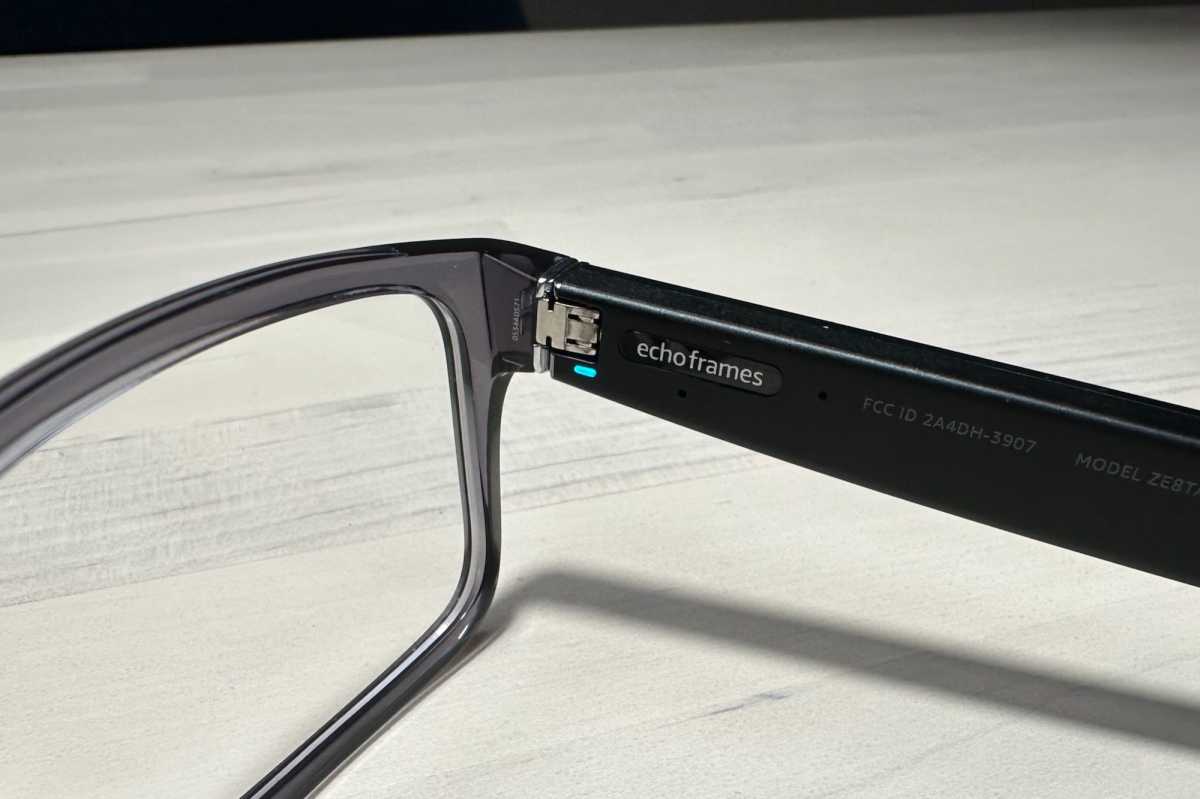
The Alexa indicator LED can light up on either the right or left sides.
Ben Patterson/Foundry
Speakers and microphones
The new Frames now come with a total of four beam-forming microphones (two in each temple), designed to capture your—and only your—voice. That’s up from just two mics on the second-gen Frames, and overall, I found the third-gen Frames better at recognizing the “Alexa” wake word (which I changed to “Echo” via the Alexa app settings) than the prior version. There was also a welcome absence of mistaken Alexa wakes, which was a recurring problem with the second-gen Frames.
Meanwhile, the third-generation Frames have fewer speakers than the older Frames—just two rather than four. But Amazon claims the new speakers are substantially better, with improved volume, better high-end performance, and up to twice the bass response.
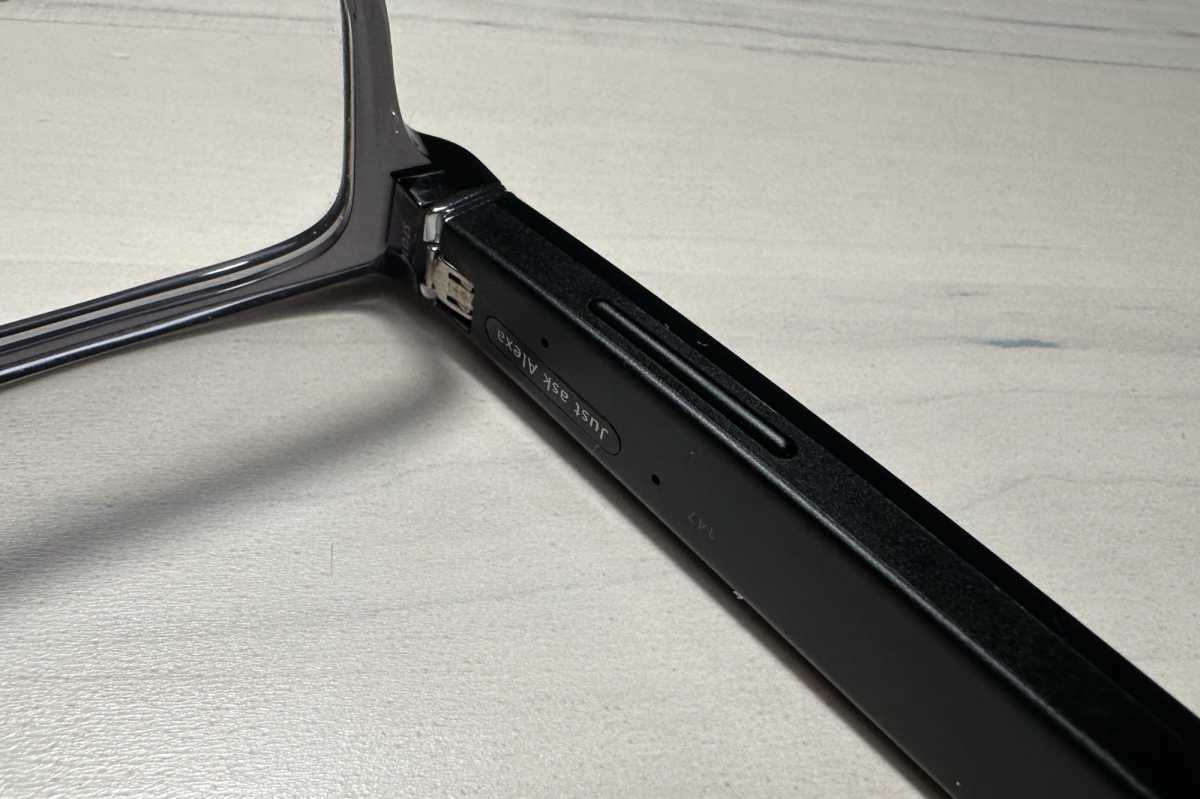
For the third-gen Frames, the volume rocker has been shifted over to the underside of the left temple.
Ben Patterson/Foundry
Comparing the second- and third-gen Frames, I can attest that the new glasses do sound better than the old, with clearer, more refined sound, but that’s just relatively speaking. While the new Frames sound good for smart glasses, they’re absolutely not a match for a decent pair of wireless earbuds, and double the bass of the older Frames’ practically nil bass still adds up to almost nothing in the low-frequency department. In short, calls, podcasts, and Alexa sound good on the Frames; music, not so much.
The dipole speakers on the Frames are designed to keep audio in just your ears, but those nearby will be able to hear the sound if the speakers are cranked too loud. Amazon recommends holding the glasses at arm’s length and dialing down the volume until the audio is undetectable, and that trick is relatively effective at keeping sound from leaking out to those around. Oddly, an auto-volume feature on the second-gen Frames that automatically adjusted the volume depending on the ambient noise is missing from the new Frames’ feature set.
Setup and notifications
Getting the third-generation Echo Frames up and running is virtually unchanged from the second-gen Frames. You just fire up the Alexa app, tap the “+” button to add a new Alexa device, and wait for the app to detect the Frames. Once that’s done, the app will guide you through a few key tricks and features, and you’re on your way.
One of the features you’ll want to try is VIP Filter, which works just the same as it did with the second-generation Frames. Basically, the filter lets you decide which apps on your phone are allowed to trigger notifications on the Frames, meaning you can get (for example) calendar alerts over the Frames speakers while filtering out Slack, Mail, or another app.
You can also choose whether you want notifications signaled with a simple chime or with a chime plus a brief Alexa-voiced description. The descriptions are skipped if you’re listening to music, on a call, or otherwise busy with another activity; either way, you can always hear the description with a single-press on the front action button.
Another setup detail worth mentioning is that you can now pair the Frames with another device besides your phone, such as a PC or a tablet. Doing so allows you to seamlessly switch the Frames’ audio from one device to another, convenient if you want to take a Zoom call with your Frames on. That’s a big change from the second-generation Frames, which you could only pair with your phone.
Chatting with Alexa
Of course, one of the main things you can do with your Echo Frames is talk to Alexa, who functions more or less exactly as she would on an Echo speaker. I won’t regale you with all of Alexa’s abilities, from settings timers and alarms to doling out weather reports and controlling smart home devices, but it is an interesting feeling having Alexa in your head.
Whether you feel comfortable chatting with Alexa in a grocery store or another public place using your Frames is another matter, although with AirPods now ever-present in people’s ears, it’s no longer that unusual to hear lone bystanders issuing commands to their voice assistants.
And what about privacy? Well, Alexa on the Frames is bound by the same privacy policies as she is on an Echo speaker—for better or worse. As I’ve previously mentioned, the third-generation Echo Frames seem to be doing a good job at preventing Alexa from accidentally hearing the wake word, so you can be relatively confident that Alexa isn’t listening when the LED indicator light is off. You can also selectively or completely wipe your Alexa voice recordings using the Alexa app, just as you can with any other Echo device. But like any other Echo speaker, Alexa on the Frames has some inherent privacy risks (such as the potential for waking accidentally), so keep that in mind.
Extras and accessories
One nifty new feature that’s exclusive to the third-generation Echo Frames is a “find my”-type option that lets you locate your lost Frames on a map. Tapping a button copies and pastes the location to your phone’s native mapping application, thus allowing you to enable turn-by-turn directions to the wayward device. That said, the Frames’ “find my” functionality only gives the last-known position of the glasses, meaning you might not see their present location if they’re powered off.
Also new is a carrying case with a magnetic lip that folds up in a slim profile, as opposed to the bulky hinged box that accompanied the second-generation Frames. The new case opens into a triangular shape to fit the glasses. But while being far more convenient to tote around, the slimmer case could conceivably be squished if you stepped on it with your full weight. On the other hand, the older, boxier case that comes with the second-gen Frames is built like a tank.

The carrying case for the new Echo Frames folds up into a nice slim size.
Ben Patterson/Foundry
Finally, the third-generation Frames ditches the thin magnetic charging cable for a full-on charging cradle, complete with a curved “nose” upon which the bridge of the Frames rests. The cradle has a USB-C charging port in back, and a USB-C to USB-A cable is included; you’ll need to supply your own USB adapter.
Like the new carrying case, the third-gen Frames’ charging cradle has its own pros and cons. On the “pro” side, the stand offers sturdier, more reliable way to charge the Frames; in contrast, the magnetic pogo connector on the second-gen’s charging cable was finicky in terms of making a proper connection, and the cable itself had a tendency to slip off my bedside table.
On the minus side, the charging stand takes way more room in a suitcase than the older charging cable, which is easy to tuck into a backpack pocket.
As for ordering an extra charging cradle, Amazon said it will “offer charging stands to customers as accessories soon,” but didn’t give specifics in terms of pricing. A replacement charging cable for second-generation Echo Frames costs $15.
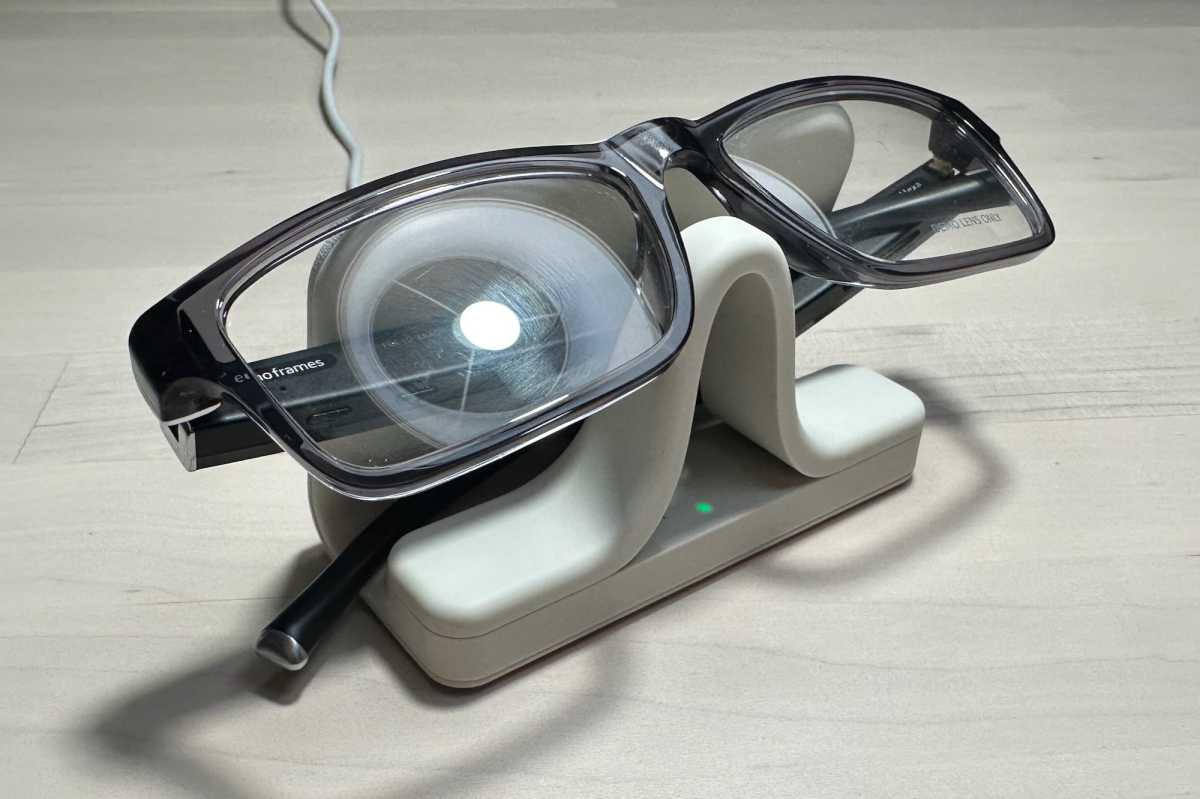
The third-gen Echo Frames come with a new charging stand, replacing the magnetic charging cable on the previous Frames.
Ben Patterson/Foundry
Battery life
Besides its claims about improved sound quality, Amazon is promising significantly better battery life from the third-generation Echo Frames. Specifically, Amazon says the new Frames will offer 6 hours of music playback at 80 percent volume, or up to 14 hours of “moderate usage,” including a mix of media playback, Alexa interaction, and incoming notifications.
To put Amazon’s claims to the test, I loaded up a track of chirping crickets (it helps soothe my tinnitus), looped it continuously on the third-gen Frames, and got roughly 7 hours of playback. In comparison, I usually only get about 4 hours of chirping crickets on my second-gen Frames (I own two pairs, swapping them out as they run out of juice) before they need a recharge. And during my version of “regular” use (that is, without the looped crickets), the new Frames easily made it through an entire day.
Amazon notes that it takes about 2.5 hours to fully recharge the third-gen Frames using a 5-watt USB adapter, and that sounds about right based on my experience.
You can put the Frames in a low-power mode via the Alexa app, or power them off by closing the temples. That latter function is slightly different than it was for the second-generation Frames, which you could power off by setting them down in an upside-down position.
Should you buy the third-generation Amazon Echo Frames?
I’m not crazy about every change to Amazon’s revamped smart glasses. For example, the handy auto-volume feature from the second-generation Frames is gone, and I’m disappointed that the touchpad was jettisoned. Also, charging the revamped frames now involves a bulky charging cradle.
That said, the latest Frames do arrive with a pair of substantial improvements: noticeably improved audio and roughly 40 percent more playback time, along with slimmer temples, multipoint Bluetooth connectivity, and perhaps best of all, more styles to choose from. Overall, the third-generation Echo Frames are the best Frames yet, even if they’re not a must-have upgrade for second-gen Frames users.
Specifications
- Configuration reviewed: Modern rectangle with prescription-ready lenses
- Size: 57 x 16 x 147 mm
- Material: Italian acetate, soft-touch silicone, metal accents, titanium core (temples)
- Compatibility: Android 9.0 or better, iOS 14 or better
- Wireless: Bluetooth 5.2, multipoint connections
- Battery life: Up to 6 hours of media playback at 80 percent volume
- IP rating: IP4X
- Weight: 38 grams (1.34 ounces)


